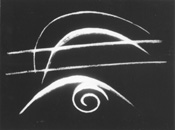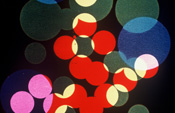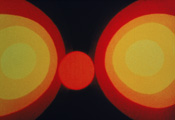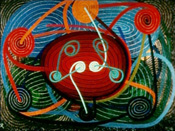
Visual music works by Oskar Fischinger (1900–67), a pioneer of visual music, are shown. These works also served as the departure point for devising the theme of this exhibition.
"Studie Nr. 7 (Study No. 7)" 1930–31, 2′35″
"Kreise (Circles)" 1933, 1′50″
"Radio Dynamics" 1942, 4′22″
"Motion Painting No. 1" 1947, 10′58″
Oskar FISCHINGER Born in Gelnhausen, Germany, in 1900. Through a literary group, Oskar FISCHINGER met film and theater critic Bernhard DIEBOLD, who encouraged him to make abstract films, around 1920. In 1921, FISCHINGER was inspired by the abstract films of Walter RUTTMANN and moved to Munich to begin his work as a filmmaker. In 1928 he moved to Berlin, where he produced the "Studie" series (1929–33)—in which abstract forms dance rhythmically in time to music—which is known as a pioneering "visual music" work expressing music through images. In 1936 he escaped the Nazi crackdown on abstract art by going to the United States where he based his activities in Hollywood. Although he provided cooperation on the Walt DISNEY animated film "Fantasia" (1940) in the early stages of production, he later disassociated himself from the film for the reason that it was not to be a purely abstract film. While "Radio Dynamics" (1942) was a silent film, it was also an experiment in expressing sound visually, expressing musical emotion through the movement of only lines and shapes. "Motion Painting No. 1" (1947) was FISCHINGER's final film. Unlike previous works, in which he employed a method sound and images were synchronized, "Motion Painting No. 1" was created using gradational changes in abstract pictures painted on plexiglass. In 1950, Fischinger devised the "Lumigraph," a huge "color organ." Late in life, despite some reluctance he devoted himself to painting and left many works. Fischinger's films and ideas also influenced many artists, including composers Edgar VARÈSE and John CAGE and filmmakers Norman McLAREN, Harry SMITH, and Kenneth ANGER. He died in Los Angeles in 1967.



